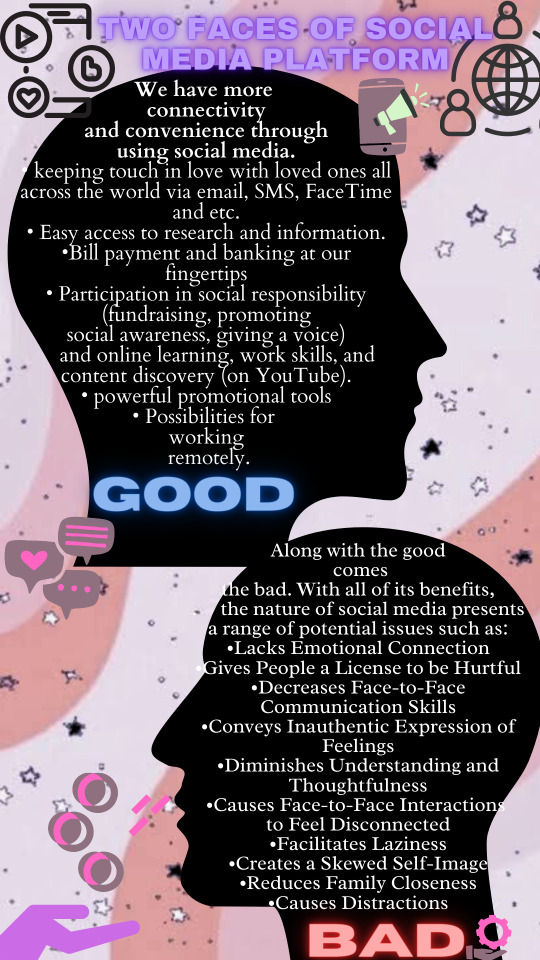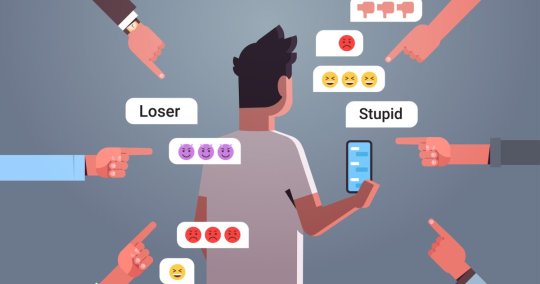#SocialMediaPlatformSmith
Explore tagged Tumblr posts
Text

THE TWO FACES OF SOCIAL PLATFORMS (Good &Bad)
Youth's wellbeing and mental health are influenced by social media in ways that are good and bad.Social media offers numerous advantages to youth, including the opportunity for creative expression, educational possibilities, and the chance to interact with others. However, social media can also have negative impacts on the mental and physical well-being of students.
Why is social media good?
We have more connectivity and convenience thanks to social media, such as:
• keeping in touch with loved ones all across the world via email, SMS, FaceTime, etc.
• Easy access to research and information
• Bill payment and banking at our fingertips
• Participation in social responsibility (fundraising, promoting social awareness, giving a voice) and online learning, work skills, and content discovery (on YouTube).
• Powerful promotional tools
• Possibilities for working remotely.
Therefore, technology and social media make our lives easier, but we should use them in moderation. Social media can be beneficial, but teenagers should trust their own feelings and call out a trusted adult if they ever feel uneasy about something they read or see there. This person could be a parent, a teacher, or another trusted adult. Social media bullying, threats, and violence are all indications that the individual who did it needs support.
Why is social media bad and what is the disadvantages of using social media?
•Lacks Emotional Connection
•Gives People a License to be Hurtful
•Decreases Face-to-Face Communication Skills
•Conveys Inauthentic Expression of Feelings
•Diminishes Understanding and Thoughtfulness
•Causes Face-to-Face Interactions to Feel Disconnected
•Facilitates Laziness
•Creates a Skewed Self-Image
•Reduces Family Closeness
•Causes Distractions
With all of its benefits, the nature of social media presents a range of potential issues.
Online vs. reality: Social media itself is not the problem. It is the way people use it in place of actual communication and in-person socializing. "Friends" on social media may not actually be friends and may even be strangers. Increased usage. The more time spent on social media, the more it can lead to cyberbullying, social anxiety, depression, and exposure to content that is not age-appropriate. Social Media is addicting. When you’re playing a game or accomplishing a task, you seek to do it as well as you can. Once you succeed, your brain will give you a dose of dopamine and other happiness hormones, making you happy. The same mechanism functions when you post a picture to Instagram or Facebook. Once you see all the notifications for likes and positive comments popping up on your screen, you’ll subconsciously register them as a reward. But that’s not all; social media is full of mood-modifying experiences and self-image issues. Social media sites provide tools that allow people to earn others’ approval for their appearance and the possibility to compare themselves to others. It can be associated with body image concerns. The "selfieholics" and people who spend most of their time posting and scrolling are the ones most vulnerable to this.
In fact, most college girls who use Facebook at least five times a day are likely to link their self-worth to their looks. That doesn’t mean that the main problem is social media; it only provides a medium for it, which further elevates the problem. It also promotes the same sort of behavior in others.
7 notes
·
View notes
Text

✨ The Two Faces of Social Platforms (Good and Bad) + Photo Editing ✨
Social media platforms allow users to have conversations, share information and create web content. There are many forms of social media, including blogs, micro-blogs, wikis, social networking sites, photo-sharing sites, instant messaging, video-sharing sites, podcasts, widgets, virtual worlds, and more.
Social media can be beneficial for teenagers, but if they ever experience any unease about what they read or see there, they should trust their instincts and talk to an adult, such as a parent, teacher, or other respected adult. On-line bullying, threats, and cruelty are all indications that the individual engaging in them needs assistance.
💌💐by zeibiala
4 notes
·
View notes
Text

° My Ideas about the Two Faces of Social Platforms (GOOD & BAD) + Photo Editing °
#SocialMediaPlatformSmith
4 notes
·
View notes
Text
My Ideas about the Two Faces of Social Platforms (GOOD & BAD)

0 notes
Text
"Two Faces: The Good and Bad Side of Social Media Platforms."

The Good aspect of Social media platforms:
The beneficial element of social platforms is that they serve as a bridge to communication. By using social platforms, engagement among individuals from all over the world grows increasingly accessible and widespread. We can simply converse with a virtual image using this, and we may additionally establish friends through several social applications. Social platforms are also very significant because we can simply acquire an overview of the latest news and topics through internet apps, making it easier for us to inclined interaction. Social media platforms are also used to raise awareness by publishing and disseminating information, as well as to advertise businesses with the aim to increase consumer growth and recognition.
The Negative side of Social media platforms:
The negative aspect of social platforms is that they are increasing the risk of depression and anxiety for numerous users due to the toxic and harsh content and posts shared on many social platforms. Furthermore, social platforms are highly susceptible to online threats, cyberbullying, scams, and the spread of false information or rumors. Because of the aforementioned problem, social platforms have become a target for online predators in pursuit of victims and utilizing social media as a tool for blackmailing users in order to gain a significant sum of money and satisfaction. As a result, many users have abandoned social media, fearful of the dangers they may face.
0 notes
Text

The world have been using social platforms since it's created, It has become reliable to us and it became part of everyday's life.
Social platforms have different type of purpose one of them is communication, staying connected to our family and friends anytime worldwide have become easy via Facebook, What'sapp and other social media platforms. Also a lot of things have improve including communication, paying bills, shopping, a quick access to information and even fundraising, Offering us a greater convenience and connectivity.
Along with the good comes bad, Although social platforms have many good concepts, there are still negative effects to it's users, Social platform itself is a good thing but the way person use it matters.
Teens can feel uncomfortable on what they see on the internet it could be a life threatening situation, there are chance that teen could commit suicide because of what they read or what they see on the internet.
Nowadays scammers have been a common thing, a lot of victims have lost their money by sharing their information on public and not knowing what are the consequences.
0 notes
Text
#SocialMediaPlatformSmith
GOOD AND BAD OF SOCIAL PLATFORMS

Multitasking has become a common theme in our lives. It’s a wonder how we manage it all.
We depend on our smartphones for work, school, our personal and social lives. When was the last time you left home without your phone and kept on going? The internet has become a significant part of our daily lives. So too has social media.
And it is having an impact on today’s teens.
Social media usage
Back in 2005, when social media was still in its infancy, only about 5 percent of users in the United States were involved in social media. In 2019, that number grew to about 70 percent.
Pew Research Center surveyed social media usage and popularity among US adults early in 2019. The survey found that while the most-used social platforms for adults are YouTube and Facebook; teens prefer SnapChat and Instagram, while TikTok is reportedly the fastest growing social network among younger users.
Social media use is nearly universal among today’s teens. Pew Research Center reports 97 percent of 13- to 17-year-olds use at least one of seven major online platforms.
The amount of time spent on social sites is astounding. One report indicates the average teen ages 13 to 18 spends about nine hours on social media each day; tweens ages 8 to 12 are on for about six hours a day.
Like most things, using social media has its positives (the good), its cautionary tales (the bad), and dangers (the ugly) that lurk and impact the lives of many, but especially teens.
Mindcast: Healthy Mind, Healthy Child Podcast
A Podcast from the experts at Bradley Hospital, leaders in mental health care for children.
Listen to the podcast
Why is social media good?
Social media and technology offer us greater convenience and connectivity:
staying connected with family and friends worldwide via email, text, FaceTime, etc.
quick access to information and research
banking and bill pay at our fingertips
online learning, job skills, content discovery (YouTube)
involvement in civic engagement (fundraising, social awareness, provides a voice)
great marketing tools
opportunities for remote employment
Social media can be a good thing, but if teens ever feel uncomfortable about something they see or read on social, they should trust their own feelings and talk to someone – a parent, a teacher, or another trusted adult. Bullying, threats and cruelty on social media are all signs that the person doing those things needs help.
Why is social media bad?
Along with the good comes the bad. With all of its benefits, the nature of social media presents a range of potential issues.
•Online vs Reality. Social media itself is not the problem. It is the way people use it in place of actual communication and in-person socializing. “Friends” on social media may not actually be friends, and may even be strangers.
•Increased usage. The more time spent on social media can lead to cyberbullying, social anxiety, depression, and exposure to content that is not age appropriate.
•Social Media is addicting. When you’re playing a game or accomplishing a task, you seek to do it as well as you can. Once you succeed, your brain will give you a dose of dopamine and other happiness hormones, making you happy. The same mechanism functions when you post a picture to Instagram or Facebook. Once you see all the notifications for likes and positive comments popping up on your screen, you’ll subconsciously register it as a reward. But that’s not all, social media is full of mood-modifying experiences.
•Fear of Missing Out. FOMO has become a common theme, and often leads to continual checking of social media sites. The idea that you might miss out on something if you’re not online can affect your mental health.
•Self-image issues. Social media sites provide tools that allow people to earn others’ approval for their appearance and the possibility to compare themselves to others. It can be associated with body image concerns. The “selfieholics” and people who spend most of their time posting and scrolling are the ones most vulnerable to this. In fact, most college girls who use Facebook at least five times a day are likely to link their self-worth to their looks. That doesn’t mean that the main problem is social media; it only provides a medium for it, which further elevates the problem. It also promotes the same sort of behavior to others.

Social media and bullying
Sadly, there is an ugly side to all that technology offers. While bullying is not a new concept, social media and technology have brought bullying to a new level. It becomes a more constant, ever-present threat -- cyberbullying. The State of Rhode Island anti-bullying laws & regulations define bullying and cyberbullying as follows:
“Bullying” means the use by one or more students of a written, verbal or electronic expression or a physical act or gesture or any combination thereof directed at a student that:
• causes physical or emotional harm to the student or damage to the student's property
• places the student in reasonable fear of harm to himself/herself or of damage to his/her property
• creates an intimidating, threatening, hostile, or abusive educational environment for the student
• infringes on the rights of the student to participate in school activities
• materially and substantially disrupts the education process or the orderly operation of a school

“Cyberbullying” means bullying through the use of technology or any electronic communication, which shall include, but not be limited to, any transfer of signs, signals, writing, images, sounds, data, texting or intelligence of any nature transmitted in whole or in part by a wire, radio, electromagnetic, photo electronic or photo optical system, including, but not limited to, electronic mail, Internet communications, instant messages or facsimile communications.
BULLYING STATISTICS
Every 7 minutes a child is bullied. Unfortunately, intervention is rare, with an adult intervening in only four percent of cases, and a peer in 11 percent. An astonishing 85 percent of all cases of bullying are not addressed.
The following are just some statistics on how common bullying and cyberbullying have become: According to StopBullying.org:
•One out of four (25 percent) teens are bullied, while up to 43 percent have been bullied while online.
•Nine out of ten LGBTQ students experienced harassment at school and online. Biracial and multiracial youth are more likely to be victimized than youth who identify with a single race. Kids who are obese, gay, or have disabilities are more likely to be bullied than other children.
•58 percent have not told their parents or an adult about something mean or hurtful that happened to them online.
•5.4 million children stay home on any given day because they fear being bullied.
7 Ways To Stop The Negative Effects of Social Media:
1. Take a Break
Taking a break from social media allows you to rest, recharge, and regroup.
2. Create an Intention or Purpose
My intent for using Facebook was to keep in touch with friends and acquaintances near and far.
3. Connect with Those That Lift You Up, not Put You Down
They pressured me into accepting Facebook friend requests at my worst job ever.
4. Change Your Perspective
There are at least two ways to look at photos, status updates, and comments.
5. Keep Your Content Positive
Negative content can trigger negative emotions.
It can cause you to assume the worst about everything.
Worse, you might have difficulty accepting good things in your life because you don’t believe you deserve them.
6. Contribute to the Cause
According to a study, users who are actively posting, commenting, liking, and sharing content are more likely to feel a sense of bonding and inclusiveness with others on social media.
7. Remember That You Are In-Charge
Ultimately, you are responsible for your emotions.
It is not Facebook, Instagram, Twitter, or other forms of social media.
Although there are important benefits, social media can also provide platforms for bullying and exclusion, unrealistic expectations about body image and sources of popularity, normalization of risk-taking behaviors.
REMEMBER NOT TO BULLY, AND OFCOURSE DON'T ALLOW YOURSELF TO BE BULLIED.
0 notes
Text

Two Faces of Social Media Paltform📢
Social media is a collective term for websites and applications that focus on communication, community-based input, interaction, content-sharing and collaboration. People use social media to stay in touch and interact with friends, family and various communities. It's very useful but dangerous.
#SocialMediaPlatformSmith
0 notes





